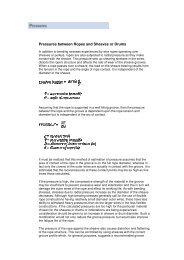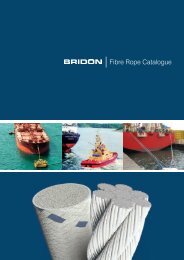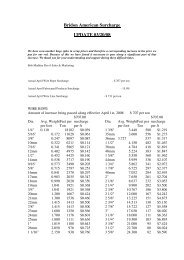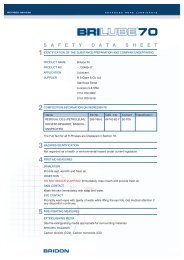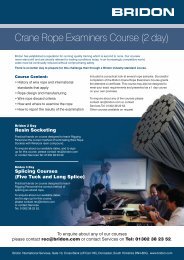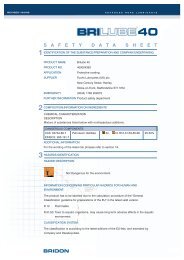Download the full Mining Brochure (Metric) - Bridon
Download the full Mining Brochure (Metric) - Bridon
Download the full Mining Brochure (Metric) - Bridon
- No tags were found...
You also want an ePaper? Increase the reach of your titles
YUMPU automatically turns print PDFs into web optimized ePapers that Google loves.
Technical Information10. Fleet AngleOf all <strong>the</strong> factors which have some influence on <strong>the</strong> windingof a rope on a smooth drum, <strong>the</strong> fleet angle, arguably, has<strong>the</strong> greatest effect.Fleet angle is usually defined as <strong>the</strong> included anglebetween two lines, one which extends from a fixed sheaveto <strong>the</strong> flange of a drum and <strong>the</strong> o<strong>the</strong>r which extends from<strong>the</strong> same fixed sheave to <strong>the</strong> drum in a line perpendicularto <strong>the</strong> axis of <strong>the</strong> drum. (See illustration).Illustration of Fleet AngleAt <strong>the</strong> sheaveWhere a fleet angle exists as <strong>the</strong> rope enters a sheave, itinitially makes contact with <strong>the</strong> sheave flange. As <strong>the</strong> ropecontinues to pass through <strong>the</strong> sheave it moves down <strong>the</strong>flange until it sits in <strong>the</strong> bottom of <strong>the</strong> groove. In doing so,even when under tension, <strong>the</strong> rope will actually roll as wellas slide. As a result of <strong>the</strong> rolling action <strong>the</strong> rope is twisted,i.e. turn is induced into or out of <strong>the</strong> rope, ei<strong>the</strong>r shorteningor leng<strong>the</strong>ning <strong>the</strong> lay length of <strong>the</strong> outer layer of strands.As <strong>the</strong> fleet angle increases so does <strong>the</strong> amount of twist.Fleet angleSheaveTo reduce <strong>the</strong> amount of twist to an acceptable level <strong>the</strong>fleet angle should be limited to 2.5 O for grooved drums and1.5 O for plain drums and when using rotation-resistant lowrotation and parallel-closed ropes <strong>the</strong> fleet angle should belimited to 1.5 O .DrumIf <strong>the</strong> drum incorporates helical grooving, <strong>the</strong> helix angle of<strong>the</strong> groove needs to be added or subtracted from <strong>the</strong> fleetangle as described above to determine <strong>the</strong> actual fleetangle experienced by <strong>the</strong> rope.At <strong>the</strong> drumWhen spooling rope onto a drum it is generallyrecommended that <strong>the</strong> fleet angle is limited to between 0.5 Oand 2.5 O . If <strong>the</strong> fleet angle is too small, i.e. less than 0.5 O ,<strong>the</strong> rope will tend to pile up at <strong>the</strong> drum flange and fail toreturn across <strong>the</strong> drum. In this situation, <strong>the</strong> problem maybe alleviated by introducing a ‘kicker’ device or byincreasing <strong>the</strong> fleet angle through <strong>the</strong> introduction of asheave or spooling mechanism.If <strong>the</strong> rope is allowed to pile up it will eventually roll awayfrom <strong>the</strong> flange creating a shock load in both <strong>the</strong> rope and<strong>the</strong> structure of <strong>the</strong> mechanism, an undesirable and unsafeoperating condition.Excessively high fleet angles will return <strong>the</strong> rope across <strong>the</strong>drum prematurely, creating gaps between wraps of ropeclose to <strong>the</strong> flanges as well as increasing <strong>the</strong> pressure on<strong>the</strong> rope at <strong>the</strong> cross-over positions.Even where helical grooving is provided, large fleet angleswill inevitably result in localised areas of mechanicaldamage as <strong>the</strong> wires ‘pluck’ against each o<strong>the</strong>r. This isoften referred to as ‘interference’ but <strong>the</strong> amount can bereduced by selecting a Langs lay rope if <strong>the</strong> reeving allows.The “interference” effect can also be reduced by employinga Dyform rope which offers a much smoo<strong>the</strong>r exteriorsurface than conventional rope constructions.However, for some applications it is recognised that forpractical reasons it is not always possible to comply with<strong>the</strong>se general recommendations, in which case <strong>the</strong> rope lifecould be affected.11. Rope TorqueThe problem of torsional instability in hoist ropes would notexist if <strong>the</strong> ropes could be perfectly torque balanced underload. The torque generated in a wire rope under load isusually directly related to <strong>the</strong> applied load by a constant‘torque factor’. For a given rope construction <strong>the</strong> torquefactor can be expressed as a proportion of <strong>the</strong> ropediameter and this has been done below..Variation with rope construction is relatively small andhence <strong>the</strong> scope for dramatically changing <strong>the</strong> stability of ahoisting system is limited. Never<strong>the</strong>less <strong>the</strong> choice of <strong>the</strong>correct rope can have a deciding influence, especially insystems which are operating close to <strong>the</strong> critical limit. Itshould be noted that <strong>the</strong> rope torque referred to here ispurely that due to tensile loading. No account is taken of<strong>the</strong> possible residual torque due, for example, to ropemanufacture or installation procedures.Torsional StabilityThe torque factors quoted on page 37 are approximatemaximum values for <strong>the</strong> particular constructions. Tocalculate <strong>the</strong> torque value for a particular rope size multiplyby <strong>the</strong> nominal rope diameter. Example: for 20mm dia.Tiger 34LR 34x7 Class at 20% of minimum breaking force:-Torque value= torque factor x rope dia.= 0.8% x 20mm= 0.16mmFloating sheaves or specially designed fleet anglecompensating devices may also be employed to reduce<strong>the</strong> fleet angle effect.36 BRIDON <strong>Mining</strong>



